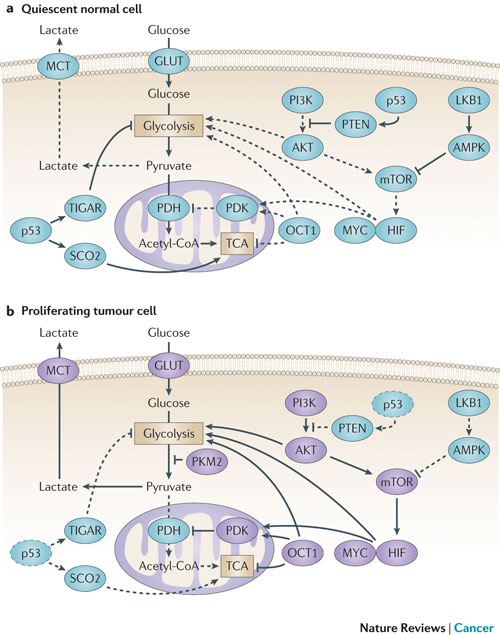Warburg effect signaling pathway
Based on Luminex technology platform, Creative Proteomics provides analysis services for key targets of warburg effect signaling pathway.
 (Shen, Y., et al., 2019)The Warburg effect or "aerobic glycolysis" refers to the fact that in cancer cells or other highly proliferative cell types, most of the pyruvate produced by glycolysis is directed away from the mitochondria to produce lactate by the action of lactate dehydrogenase (LDH/LDHA), a process normally reserved for the hypoxic state, and in the presence of oxygen.
(Shen, Y., et al., 2019)The Warburg effect or "aerobic glycolysis" refers to the fact that in cancer cells or other highly proliferative cell types, most of the pyruvate produced by glycolysis is directed away from the mitochondria to produce lactate by the action of lactate dehydrogenase (LDH/LDHA), a process normally reserved for the hypoxic state, and in the presence of oxygen.
The Warburg effect helps cancer cells use additional ATP to meet the high energy demands of their extraordinary growth while providing the basic building blocks of metabolites for their proliferation. Warburg effect is part of a metabolic reprogramming that has been known since the 1920s. Instead of metabolizing glucose by oxidative phosphorylation and shuttling glycolytic products into the TCA cycle, cancer cells use much more glucose than normal cells and convert glucose to lactate via aerobic glycolysis. These metabolic changes can produce precursors for the formation of nascent material. In many cases, metabolic events do not appear to be oncogenic drivers, but can be triggered by other events in the oncogenic process. For example, activation of the PI3K pathway leads to a high rate of aerobic glycolysis through alterations in enzymes and glucose transport proteins.
The Warburg effect is a defense mechanism that protects cancer cells from the higher than usual oxidative environment in which they survive. the Warburg effect is due, at least in part, to the fact that cancer cells do not utilize their mitochondria to the same extent and in the same manner as non-cancerous cells. In recent years, studies have identified mechanisms that contribute to the Warburg effect. The main ones include (1) stabilization of the tumor microenvironment and HIF, (2) oncogene activation and loss of tumor suppressor genes, and (3) mitochondrial dysfunction in cancer cells. (4) nuclear DNA mutations, (5) epigenetic changes. (6) miRNA. (7) glutamine metabolism, and (8) post-translational modifications.
Our detectable targets:
| AKT | c-Myc | ULK1 | PFK | PHGDH | Erk1 |
| Erk2 | LKB1 | LDHA | ANT | VDAC | Bax |
| UCP2 | PDHK | LC3I | PROLC3 | ULK | FIP200 |
| VPS15 | VPS34 | UYRAG | NFκB | RIG-1 | TRAF3 |
| IPS-1 | ISGF3 | MSK2 | PI3K | TBK1 | Vav |
| GAS | IRF9 | AMBRA1 | p38 | RIP1 | TRAF5 |
| IKK-β | IRS2 | MSK1 | p65 | Tak1 | TLR3 |
| Histone-H3 | IRF5 | MEK3 | p38MAPK | SH2 | TRAF6 |
| IKK-α | IRS1 | MEK6 | p50 | p53 | TRAM |
| TRIF | IRAK1 | ISRE | mTOR | PKR |
Technology platform:
We provide Luminex technology for warburg effect signaling pathway analysis.
Luminex technology is a multifunctional liquid phase analysis platform developed on the basis of high-speed digital signal processing technology, colored microspheres, applied fluidics and laser technology. The core is the use of fluorescent dyes to encode magnetic microspheres and polypropylene microspheres. By adjusting the different ratios of different fluorescent dyes, more than 100 microspheres with different fluorescence spectra are obtained. Reactions are carried out on microspheres with different fluorescent codes, such as nucleic acid hybridization, antigen-antibody, enzyme-substrate, ligand-receptor binding reactions. Using laser detection technology, qualitative and quantitative analysis of microsphere encoding and reporting fluorescence.
In addition to Luminex multiplex assay, enzyme-linked immunosorbent assay (ELISA), flow cytometry (FACS analysis) technology can also be provided to meet other customer needs.
Advantages of warburg effect signaling pathway detection:
- High sensitivity: The surface area of the microspheres is large, and 100,000 probes can be fixed on each microsphere, which ensures the maximum binding with the target molecules in the sample and improves the detection sensitivity. The lowest detection concentration can reach 0.1pg/mL.
- Strong specificity: Can read the fluorescent signal on a single microsphere, and automatically distinguish between bound and unbound microspheres.
- High accuracy: Without washing, the fluorescence intensity of the reporter molecule on the microsphere is proportional to the bound molecule to be detected. Because the detection range of the Luminex detection platform is large, it does not need to be diluted like ELISA detection, which further reduces errors.

Application of our service:
- Study the regulatory mechanism of warburg effect signaling pathway in clinical diseases
- Study the influence of various human viruses on the warburg effect signaling pathway
- Study the influence of carcinogenic drugs or therapies on the signal pathway of warburg effect
Creative Proteomics has developed a signal pathway target detection platform. We are not limited to providing warburg effect signal path detection services, but can also provide other signal path detection services. If you want to detect other targets, please contact us and we will customize the service for you. Look forward to working with you.
References:
- Benjamin K. Tsang, et al. Molecular and Cellular Basis of Chemoresistance in Ovarian Cancer Meshach Asare-Werehene, in The Ovary (Third Edition), 2019.
- Shen, Y., Chen, G., et al. Arhgap4 mediates the warburg effect in pancreatic cancer through the mtor and hif-1α signaling pathways. OncoTargets and therapy, 2019, 12, 5003.
- Samudio I, Fiegl M, et al. Mitochondrial uncoupling and the Warburg effect: molecular basis for the reprogramming of cancer cell metabolism. Cancer Res, 2019, 69(6): 2163–2166.
- Cairns, R. A., Harris, I. S., & Mak, T. W. (2011). Regulation of cancer cell metabolism. Nature Reviews Cancer, 11(2), 85-95.



